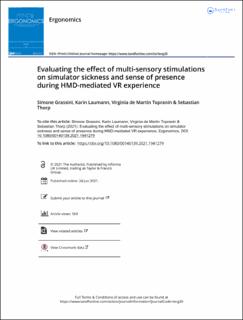| dc.contributor.author | Grassini, Simone | |
| dc.contributor.author | Laumann, Karin | |
| dc.contributor.author | De Martin Topranin, Virginia | |
| dc.contributor.author | Thorp, Sebastian | |
| dc.date.accessioned | 2021-11-04T11:49:49Z | |
| dc.date.available | 2021-11-04T11:49:49Z | |
| dc.date.created | 2021-10-27T19:12:03Z | |
| dc.date.issued | 2021 | |
| dc.identifier.issn | 0014-0139 | |
| dc.identifier.uri | https://hdl.handle.net/11250/2827859 | |
| dc.description.abstract | Some lines of evidence have shown that sensory input, especially related to vestibular and somatosensory stimulation, may reduce the symptoms related to simulator sickness and increase the sense of presence in VR. The present study aims at understanding how mechanical vibration and auditory stimulation can be used to improve user experience in the context of VR mediated by head-mounted displays. Four different groups comprising a total of 80 participants were tested under different conditions of sensory input (visual and vibration, visual-auditory, combined visual-auditory and vibratory, and visual only), during a VR roller-coaster experience. No significant differences in simulator sickness were found between the groups exposed to seat vibration and/or audio. However, sense of presence showed to be increased when vibratory stimuli were included. Post-hoc analyses showed that female users but not male ones, experienced an increase of sense of presence when vibratory stimulation was used.
Practitioner summary: The study showed that including sound or vibration stimulation during VR experience does not reduce simulator sickness. However, sense of presence is promoted by vibratory stimulation. Post-hoc analyses showed that female users experienced an increase of sense of presence by vibratory stimulation, but not male ones. | en_US |
| dc.language.iso | eng | en_US |
| dc.publisher | Taylor & Francis | en_US |
| dc.rights | Attribution-NonCommercial-NoDerivatives 4.0 Internasjonal | * |
| dc.rights.uri | http://creativecommons.org/licenses/by-nc-nd/4.0/deed.no | * |
| dc.title | Evaluating the effect of multi-sensory stimulations on simulator sickness and sense of presence during HMD-mediated VR experience | en_US |
| dc.type | Peer reviewed | en_US |
| dc.type | Journal article | en_US |
| dc.description.version | publishedVersion | en_US |
| dc.source.journal | Ergonomics | en_US |
| dc.identifier.doi | 10.1080/00140139.2021.1941279 | |
| dc.identifier.cristin | 1949074 | |
| cristin.ispublished | true | |
| cristin.fulltext | original | |
| cristin.qualitycode | 1 | |

